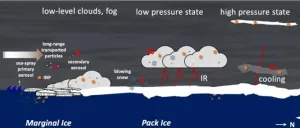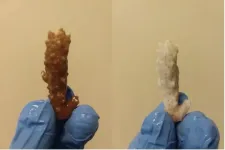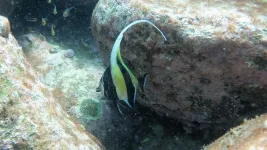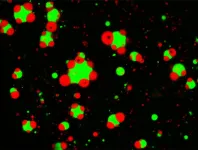Understanding catalytic couplings: not all synergies are simple
New Nature Catalysis paper provides a rationalisation of the inner workings of nickel-catalysed cross-coupling reactions
2021-02-08
(Press-News.org) Negishi cross-coupling reactions have been widely used to form C-C bonds since the 1970s and are often perceived as the result of two metals (i.e zinc and palladium/nickel) working in synergy. But like all relationships, there is more under the surface than what we first expected. PhD student Craig Day and Dr. Rosie Somerville from the Martin group at ICIQ have delved into the Negishi cross-coupling of aryl esters using nickel catalysis to understand how this reaction works at the molecular level and how to improve it. The results have been published in Nature Catalysis.
Compared to palladium, nickel has the advantage of being readily available transition metal, with unique chemical properties that allow for the activation of challenging bonds otherwise inaccessible by palladium cross-coupling endeavours. These characteristics make it attractive for the development of synthetic applications, and over the last decades, it has proven to be a rapid and reliable way to rapidly and reliably build up molecular complexity from simple and available precursors. To the researchers this Nature Catalysis paper provides a rationalisation of how and why nickel-catalysed cross-coupling reactions work at a level that wasn't attempted before. "Our work provides an unprecedented look at the speciation of Ni catalysts in Negishi cross-coupling reactions, and have unravelled a counterintuitive dichotomy exerted by Zn(II) salts in catalytic activity. Given the important role exerted by Zn in a myriad of Ni-catalysed reactions, one might expect that these transformations obey similar principles to those described in our study, thus offering new vistas for designing new catalytic systems or outperform existing ones" explains Prof. Ruben Martin, ICIQ group leader and ICREA professor.
Using an organometallic approach to investigate and identify the nickel species involved in the catalytic cycle, the team has been able to isolate the individual intermediates and show how they are all connected in the catalytic cycle. This led them to contemplate there were other meaningful, although undesired, interactions happening between the two metals nickel and zinc. "The interaction between the two metals is required for the transformation, but it can also be deleterious in other ways. Chemists need to be aware of these problems to design better catalytic reactions," quips Craig S. Day, PhD student in the group of Prof. Ruben Martín and first author of the paper.
The scientists have discovered there are three undesired off-cycle pathways happening: ligand scavenging, reduction-oxidation pathways and the formation of unorthodox Ni/Zn clusters. Although speculated for a long time, this work offers the first direct evidence of Ni-Zn interactions. In addition, the research shows the importance of the nature of the solvent used in the reaction as it plays a role in regulating the interactions of the catalyst and zinc species. In fact, looking further into the role of zinc in these systems, the researchers believe there is still more to be determined about how the properties of ligands affect the interactions among the catalytic couple.
Tying together all the concepts, the work easily extrapolates to other cross-couplings, opening up new avenues of research to explore the inner workings of different systems. "We've provided a model for how similar reactions should occur. Both in understanding how aryl-oxygen electrophiles can be functionalised and lessons in Ni-catalysed Negishi cross-coupling reactions," concludes Day.
INFORMATION:
[Attachments] See images for this press release:

ELSE PRESS RELEASES FROM THIS DATE:
2021-02-08
It's clear that rising greenhouse gas emissions are the main driver of global warming. But on a regional level, several other factors are at play. That's especially true in the Arctic - a massive oceanic region around the North Pole which is warming two to three times faster than the rest of the planet. One consequence of the melting of the Arctic ice cap is a reduction in albedo, which is the capacity of surfaces to reflect a certain amount of solar radiation. Earth's bright surfaces like glaciers, snow and clouds have a high reflectivity. As snow and ice decrease, albedo decreases and more radiation is absorbed by the Earth, leading to a rise in ...
2021-02-08
What The Study Did: Researchers investigated the association between the use of proton pump inhibitors among children and adolescents in Sweden and the risk of asthma.
Authors: Yun-Han Wang, M.Sc., B.Pharm., of the Karolinska Institutet in Stockholm, is the corresponding author.
To access the embargoed study: Visit our For The Media website at this link https://media.jamanetwork.com/
(doi:10.1001/jamapediatrics.2020.5710)
Editor's Note: The article includes conflict of interest and funding/support disclosures. Please see the article for additional information, including other authors, author contributions and affiliations, conflict ...
2021-02-08
What The Article Says: In this essay, the authors describe a 97-year-old patient who learned to titrate condensed chicken soup like a medicine during the COVID-19 pandemic.
Authors: Yuenting Diana Kwong, M.D., M.A.S., University of California, San Francisco, is the corresponding author.
To access the embargoed study: Visit our For The Media website at this link https://media.jamanetwork.com/
(doi:10.1001/jamainternmed.2020.8897)
Editor's Note: The article includes conflicts of interest disclosures. Please see the article for additional information, including other authors, author contributions and affiliations, conflict of interest and financial disclosures, ...
2021-02-08
What The Study Did: Salary information from faculty at U.S. medical schools was used to examine the association between the percentage of female clinicians in a medical specialty and the average and median salaries for that specialty.
Authors: Terrill Bravender, M.D., M.P.H., of the University of Michigan in Ann Arbor, is the corresponding author.
To access the embargoed study: Visit our For The Media website at this link https://media.jamanetwork.com/
(doi:10.1001/jamapediatrics.2020.5683)
Editor's Note: The article includes conflict of interest disclosures. Please see the article for additional information, including other authors, author ...
2021-02-08
Coral reefs are beautiful and diverse ecosystems that power the economies of many coastal communities. They're also facing threats that are driving their decline, including the planet's warming waters.
This threat hit extreme levels in 2015, when high temperatures were turning corals white around the globe. Kaneohe Bay in Hawaii was hit hard; nearly half of its corals bleached.
Hidden in the aftermath of this extreme event, however, were biochemical clues as to why some corals bleached while others were resistant, information that could help reefs better weather warming waters in the future. These clues have now been uncovered by researchers at Michigan State University and the University of Hawaii at Manoa.
"It was kind of horrifying," said coral biologist Crawford Drury, who witnessed ...
2021-02-08
Researchers at the University of Massachusetts Amherst have gained new insight into the biological processes of a chytrid fungus responsible for a deadly skin infection devastating frog populations worldwide.
Led by cell biologist Lillian Fritz-Laylin, the team describes in a paper published Feb. 8 in Current Biology how the actin networks of Batrachochytrium dendrobatidis (Bd) also serve as an "evolutionary Rosetta Stone," revealing the loss of cytoskeletal complexity in the fungal kingdom.
"Fungi and animals seem so different, but they are actually pretty closely related," says Fritz-Laylin, whose lab studies how cells move, which is a central ...
2021-02-08
The findings are published in the prestigious journal, Nature Climate Change, and calls on businesses, the financial services industry and regulators to work more closely with climate scientists.
Regulators and governments - both domestic and international - are increasingly requiring that businesses assess and disclose their vulnerability to the physical effects of climate change, for example, increased drought, bushfires and sea level rise.
"People are making strategically material decisions on a daily basis, and raising debt or capital to finance these, but the decisions may not have properly considered climate risk," said lead author Dr Tanya Fiedler from the University of Sydney Business School. ...
2021-02-08
Under increasing global warming, tropical fish are escaping warmer seas by extending their habitat ranges towards more temperate waters.
But a new study from the University of Adelaide, published in Nature Climate Change, shows that the ocean acidification predicted under continuing high CO2 emissions may make cooler, temperate waters less welcoming.
"Every summer hundreds of tropical fish species extend their range to cooler and temperate regions as the waters of their natural habitat become a little too warm for comfort," says lead author Ericka Coni, PhD student in the University's School of Biological Sciences. "For at least two decades, Australian temperate reefs have been receiving new guests ...
2021-02-08
Recycling cans and bottles is a good practice. It helps keep the planet clean.
The same is true for recycling within cells in the body. Each cell has a way of cleaning out waste in order to regenerate newer, healthier cells. This "cell recycling" is called autophagy.
Targeting and changing this process has been linked to helping control or diminish certain cancers. Now, University of Cincinnati researchers have shown that completely halting this process in a very aggressive form of breast cancer may improve outcomes for patients one day.
These results are published in the Feb. 8 print edition of the journal Developmental Cell.
"Autophagy is sort of like cell cannibalism," ...
2021-02-08
BUFFALO, N.Y. -- In cells, numerous important biochemical functions take place within spherical chambers made from proteins and RNA.
These compartments are akin to specialized rooms inside a house, but their architecture is radically different: They don't have walls. Instead, they take the form of liquid droplets that don't have a membrane, forming spontaneously, similar to oil droplets in water. Sometimes, the droplets are found alone. Other times, one droplet can be found nested inside of another. And these varying assemblies can regulate the functions the droplets perform.
A study published on Feb. 8 in Nature Communications explores how these ...
LAST 30 PRESS RELEASES:
[Press-News.org] Understanding catalytic couplings: not all synergies are simple
New Nature Catalysis paper provides a rationalisation of the inner workings of nickel-catalysed cross-coupling reactions






